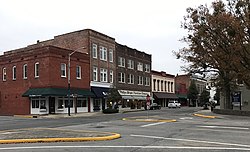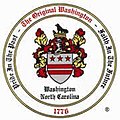Washington, North Carolina | |
|---|---|
 Washington from the corner of Stewart Street and West Main Street | |
| Nicknames: Little Washington, Original Washington | |
| Coordinates: 35°33′13″N77°03′16″W / 35.55361°N 77.05444°W | |
| Country | United States |
| State | North Carolina |
| County | Beaufort |
| Established | 1776 |
| Government | |
| • Type | Council-Manager form of government |
| • Mayor | Donald Sadler |
| Area | |
• Total | 9.02 sq mi (23.37 km2) |
| • Land | 8.19 sq mi (21.21 km2) |
| • Water | 0.83 sq mi (2.16 km2) |
| Elevation | 7 ft (2.1 m) |
| Population (2020) | |
• Total | 9,875 |
| • Density | 1,205.8/sq mi (465.55/km2) |
| Time zone | UTC−5 (Eastern (EST)) |
| • Summer (DST) | UTC−4 (EDT) |
| ZIP Code | 27889 |
| Area code | 252 |
| FIPS code | 37-71220 [3] |
| GNIS feature ID | 2405682 [2] |
| Website | www |
Washington is a city in and the county seat of Beaufort County, North Carolina, United States, [4] located on the northern bank of the Pamlico River. The population was 9,875 at the 2020 census. [5] It is commonly known as "Original Washington" or "Little Washington" to distinguish it from Washington, D.C. [6] [7] The closest major city is Greenville, approximately 20 miles (32 km) to the west.
Contents
- History
- Geography
- Climate
- Demographics
- 2020 census
- 2010 census
- Arts and culture
- Education
- Media
- Television
- Radio
- Notable people
- Notes
- References
- External links
Established in 1776 on land donated by Col. James Bonner, Washington is the first city named after George Washington, the first president of the United States. [8]







